2017 NISSAN ROGUE HYBRID fuel
[x] Cancel search: fuelPage 12 of 520
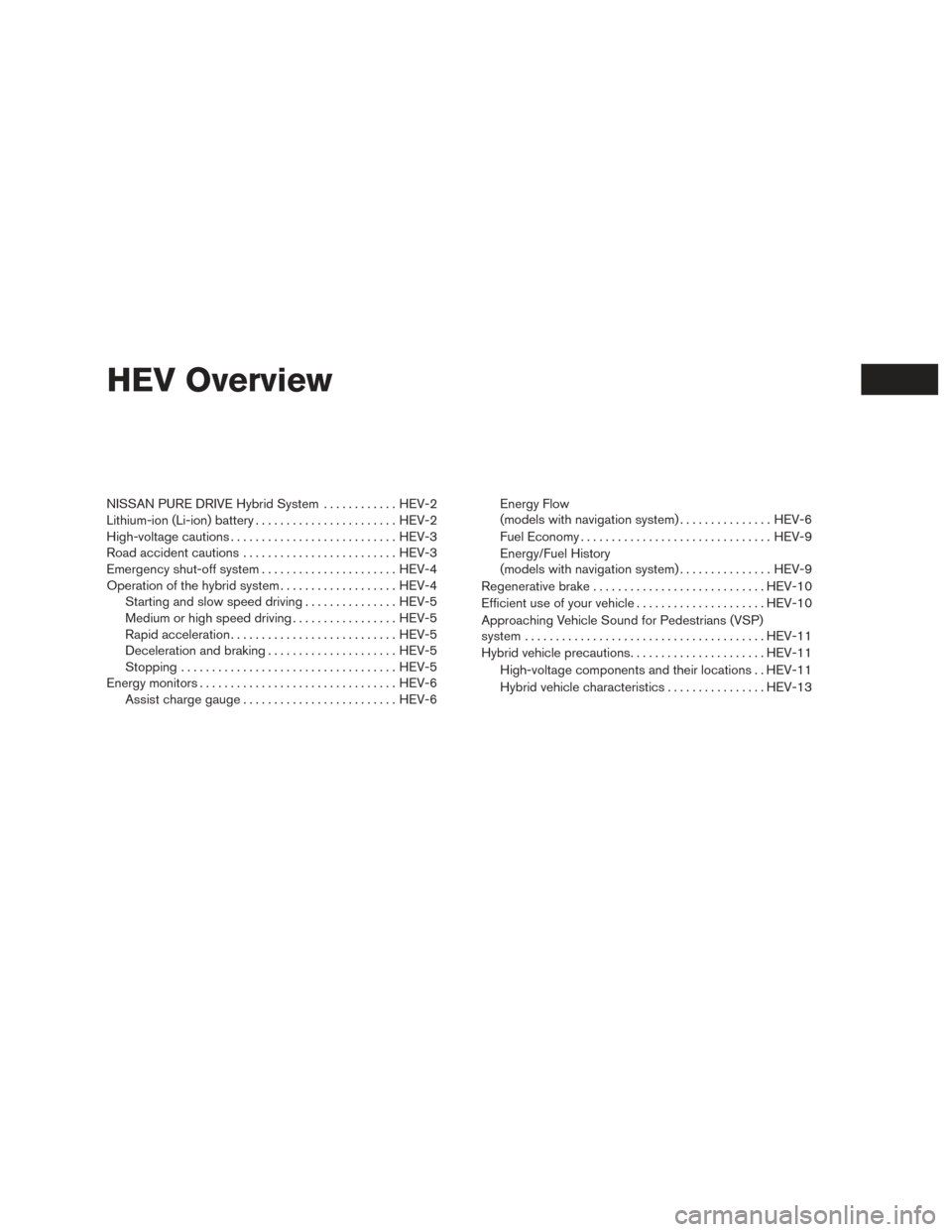
HEV Overview
NISSAN PURE DRIVE Hybrid System............HEV-2
Lithium-ion (Li-ion) battery .......................HEV-2
High-voltage cautions ........................... HEV-3
Road accident cautions ......................... HEV-3
Emergency shut-off system ......................HEV-4
Operation of the hybrid system ...................HEV-4
Starting and slow speed driving ...............HEV-5
Medium or high speed driving . . ...............HEV-5
Rapid acceleration ........................... HEV-5
Deceleration and braking .....................HEV-5
Stopping ................................... HEV-5
Energy monitors ................................ HEV-6
Assist charge gauge ......................... HEV-6Energy Flow
(models with navigation system)
...............HEV-6
Fuel Economy ............................... HEV-9
Energy/Fuel History
(models with navigation system) ...............HEV-9
Regenerative brake ............................ HEV-10
Efficient use of your vehicle .....................HEV-10
Approaching Vehicle Sound for Pedestrians (VSP)
system ....................................... HEV-11
Hybrid vehicle precautions ......................HEV-11
High-voltage components and their locations . . HEV-11
Hybrid vehicle characteristics ................HEV-13
Page 13 of 520
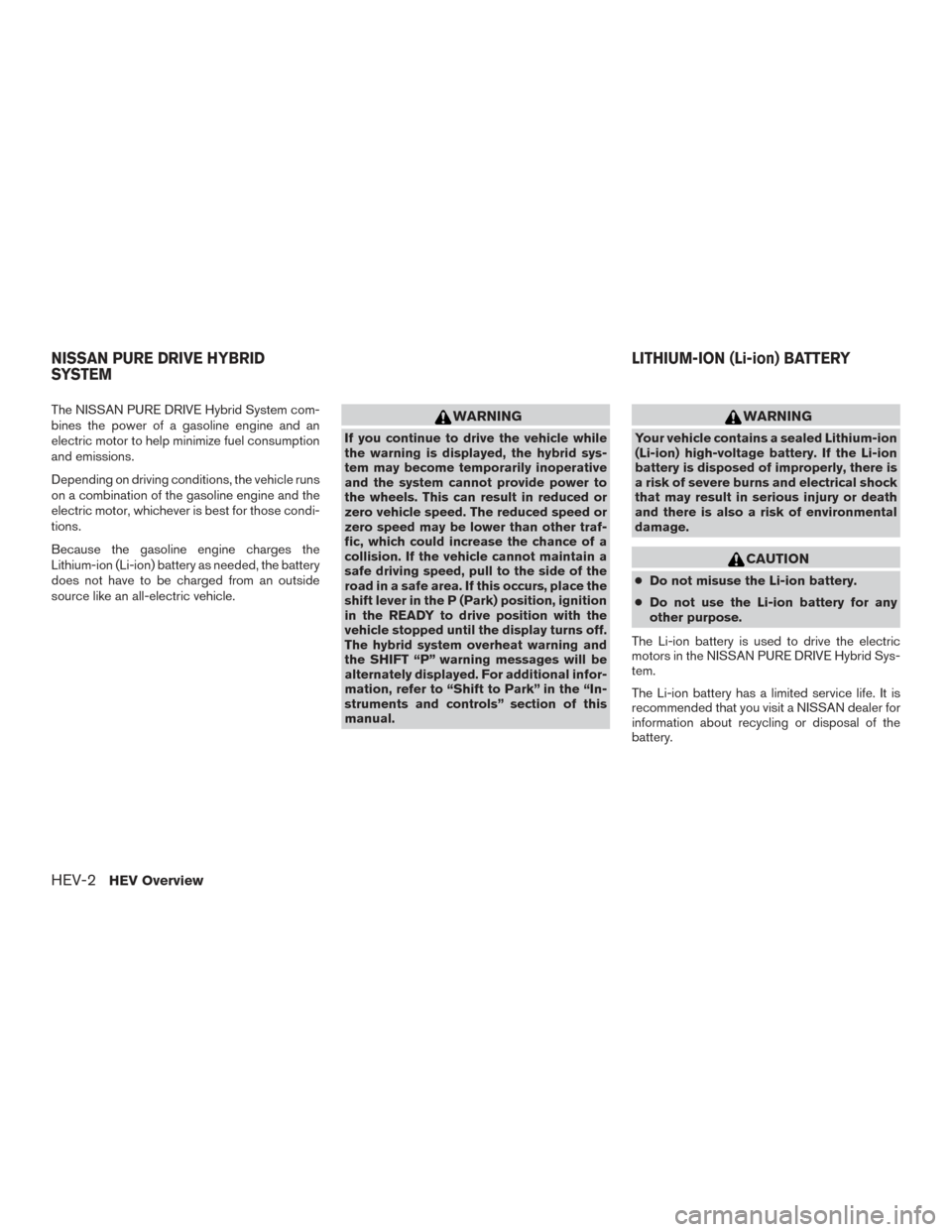
The NISSAN PURE DRIVE Hybrid System com-
bines the power of a gasoline engine and an
electric motor to help minimize fuel consumption
and emissions.
Depending on driving conditions, the vehicle runs
on a combination of the gasoline engine and the
electric motor, whichever is best for those condi-
tions.
Because the gasoline engine charges the
Lithium-ion (Li-ion) battery as needed, the battery
does not have to be charged from an outside
source like an all-electric vehicle.WARNING
If you continue to drive the vehicle while
the warning is displayed, the hybrid sys-
tem may become temporarily inoperative
and the system cannot provide power to
the wheels. This can result in reduced or
zero vehicle speed. The reduced speed or
zero speed may be lower than other traf-
fic, which could increase the chance of a
collision. If the vehicle cannot maintain a
safe driving speed, pull to the side of the
road in a safe area. If this occurs, place the
shift lever in the P (Park) position, ignition
in the READY to drive position with the
vehicle stopped until the display turns off.
The hybrid system overheat warning and
the SHIFT “P” warning messages will be
alternately displayed. For additional infor-
mation, refer to “Shift to Park” in the “In-
struments and controls” section of this
manual.
WARNING
Your vehicle contains a sealed Lithium-ion
(Li-ion) high-voltage battery. If the Li-ion
battery is disposed of improperly, there is
a risk of severe burns and electrical shock
that may result in serious injury or death
and there is also a risk of environmental
damage.
CAUTION
●Do not misuse the Li-ion battery.
● Do not use the Li-ion battery for any
other purpose.
The Li-ion battery is used to drive the electric
motors in the NISSAN PURE DRIVE Hybrid Sys-
tem.
The Li-ion battery has a limited service life. It is
recommended that you visit a NISSAN dealer for
information about recycling or disposal of the
battery.
NISSAN PURE DRIVE HYBRID
SYSTEM LITHIUM-ION (Li-ion) BATTERY
HEV-2HEV Overview
Page 14 of 520
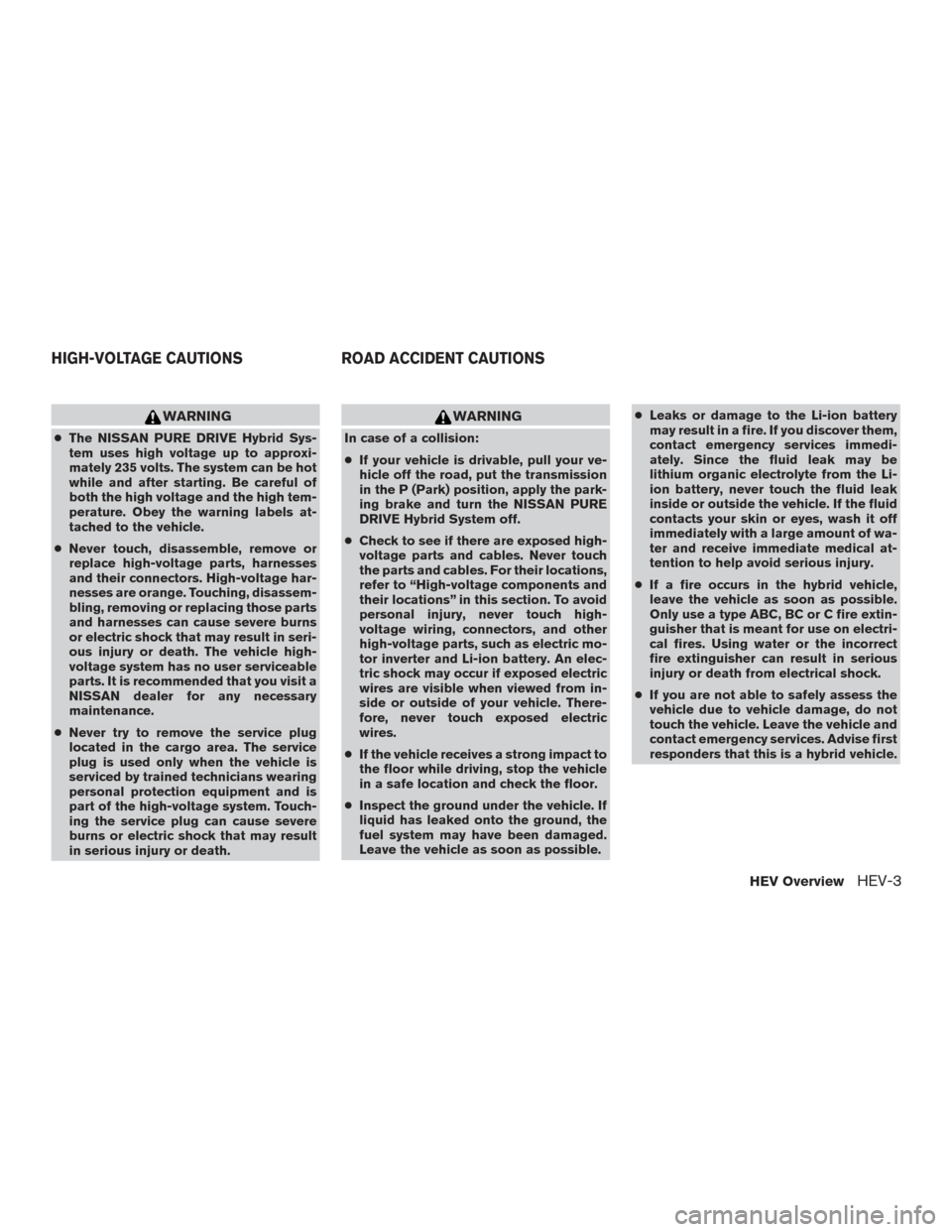
WARNING
●The NISSAN PURE DRIVE Hybrid Sys-
tem uses high voltage up to approxi-
mately 235 volts. The system can be hot
while and after starting. Be careful of
both the high voltage and the high tem-
perature. Obey the warning labels at-
tached to the vehicle.
● Never touch, disassemble, remove or
replace high-voltage parts, harnesses
and their connectors. High-voltage har-
nesses are orange. Touching, disassem-
bling, removing or replacing those parts
and harnesses can cause severe burns
or electric shock that may result in seri-
ous injury or death. The vehicle high-
voltage system has no user serviceable
parts. It is recommended that you visit a
NISSAN dealer for any necessary
maintenance.
● Never try to remove the service plug
located in the cargo area. The service
plug is used only when the vehicle is
serviced by trained technicians wearing
personal protection equipment and is
part of the high-voltage system. Touch-
ing the service plug can cause severe
burns or electric shock that may result
in serious injury or death.
WARNING
In case of a collision:
●If your vehicle is drivable, pull your ve-
hicle off the road, put the transmission
in the P (Park) position, apply the park-
ing brake and turn the NISSAN PURE
DRIVE Hybrid System off.
● Check to see if there are exposed high-
voltage parts and cables. Never touch
the parts and cables. For their locations,
refer to “High-voltage components and
their locations” in this section. To avoid
personal injury, never touch high-
voltage wiring, connectors, and other
high-voltage parts, such as electric mo-
tor inverter and Li-ion battery. An elec-
tric shock may occur if exposed electric
wires are visible when viewed from in-
side or outside of your vehicle. There-
fore, never touch exposed electric
wires.
● If the vehicle receives a strong impact to
the floor while driving, stop the vehicle
in a safe location and check the floor.
● Inspect the ground under the vehicle. If
liquid has leaked onto the ground, the
fuel system may have been damaged.
Leave the vehicle as soon as possible. ●
Leaks or damage to the Li-ion battery
may result in a fire. If you discover them,
contact emergency services immedi-
ately. Since the fluid leak may be
lithium organic electrolyte from the Li-
ion battery, never touch the fluid leak
inside or outside the vehicle. If the fluid
contacts your skin or eyes, wash it off
immediately with a large amount of wa-
ter and receive immediate medical at-
tention to help avoid serious injury.
● If a fire occurs in the hybrid vehicle,
leave the vehicle as soon as possible.
Only use a type ABC, BC or C fire extin-
guisher that is meant for use on electri-
cal fires. Using water or the incorrect
fire extinguisher can result in serious
injury or death from electrical shock.
● If you are not able to safely assess the
vehicle due to vehicle damage, do not
touch the vehicle. Leave the vehicle and
contact emergency services. Advise first
responders that this is a hybrid vehicle.
HIGH-VOLTAGE CAUTIONS ROAD ACCIDENT CAUTIONS
HEV OverviewHEV-3
Page 16 of 520
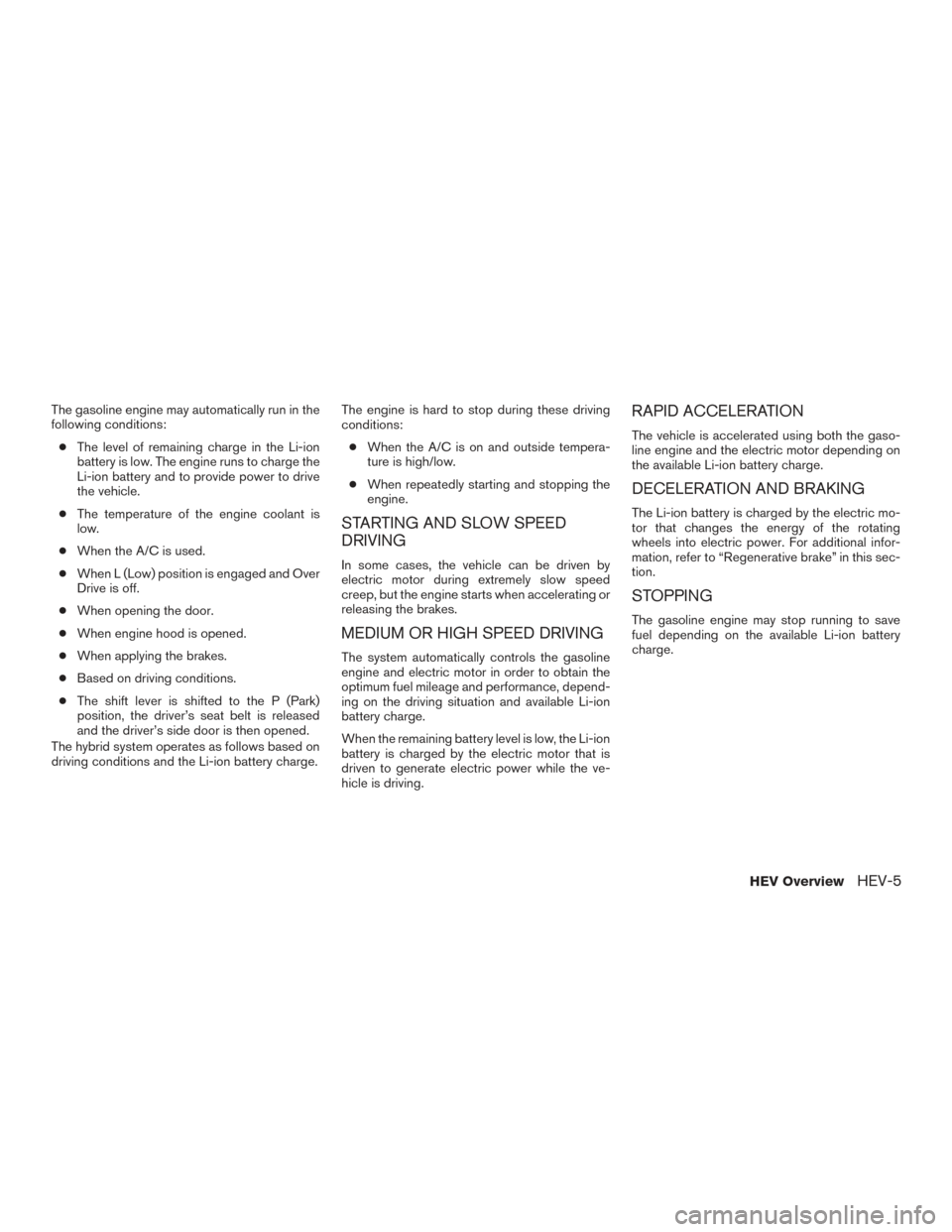
The gasoline engine may automatically run in the
following conditions:● The level of remaining charge in the Li-ion
battery is low. The engine runs to charge the
Li-ion battery and to provide power to drive
the vehicle.
● The temperature of the engine coolant is
low.
● When the A/C is used.
● When L (Low) position is engaged and Over
Drive is off.
● When opening the door.
● When engine hood is opened.
● When applying the brakes.
● Based on driving conditions.
● The shift lever is shifted to the P (Park)
position, the driver’s seat belt is released
and the driver’s side door is then opened.
The hybrid system operates as follows based on
driving conditions and the Li-ion battery charge. The engine is hard to stop during these driving
conditions:
● When the A/C is on and outside tempera-
ture is high/low.
● When repeatedly starting and stopping the
engine.
STARTING AND SLOW SPEED
DRIVING
In some cases, the vehicle can be driven by
electric motor during extremely slow speed
creep, but the engine starts when accelerating or
releasing the brakes.
MEDIUM OR HIGH SPEED DRIVING
The system automatically controls the gasoline
engine and electric motor in order to obtain the
optimum fuel mileage and performance, depend-
ing on the driving situation and available Li-ion
battery charge.
When the remaining battery level is low, the Li-ion
battery is charged by the electric motor that is
driven to generate electric power while the ve-
hicle is driving.
RAPID ACCELERATION
The vehicle is accelerated using both the gaso-
line engine and the electric motor depending on
the available Li-ion battery charge.
DECELERATION AND BRAKING
The Li-ion battery is charged by the electric mo-
tor that changes the energy of the rotating
wheels into electric power. For additional infor-
mation, refer to “Regenerative brake” in this sec-
tion.
STOPPING
The gasoline engine may stop running to save
fuel depending on the available Li-ion battery
charge.
HEV OverviewHEV-5
Page 17 of 520
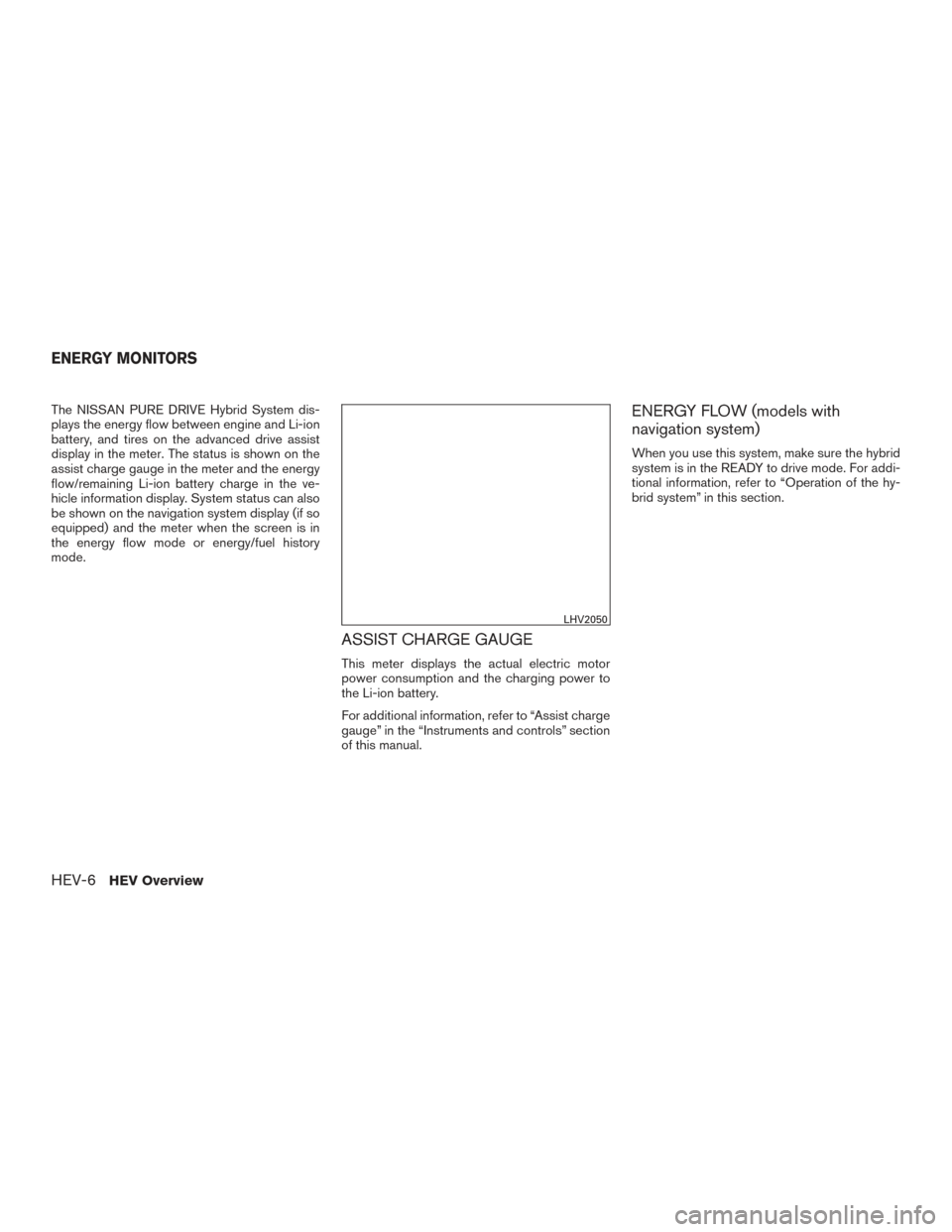
The NISSAN PURE DRIVE Hybrid System dis-
plays the energy flow between engine and Li-ion
battery, and tires on the advanced drive assist
display in the meter. The status is shown on the
assist charge gauge in the meter and the energy
flow/remaining Li-ion battery charge in the ve-
hicle information display. System status can also
be shown on the navigation system display (if so
equipped) and the meter when the screen is in
the energy flow mode or energy/fuel history
mode.
ASSIST CHARGE GAUGE
This meter displays the actual electric motor
power consumption and the charging power to
the Li-ion battery.
For additional information, refer to “Assist charge
gauge” in the “Instruments and controls” section
of this manual.
ENERGY FLOW (models with
navigation system)
When you use this system, make sure the hybrid
system is in the READY to drive mode. For addi-
tional information, refer to “Operation of the hy-
brid system” in this section.
LHV2050
ENERGY MONITORS
HEV-6HEV Overview
Page 20 of 520
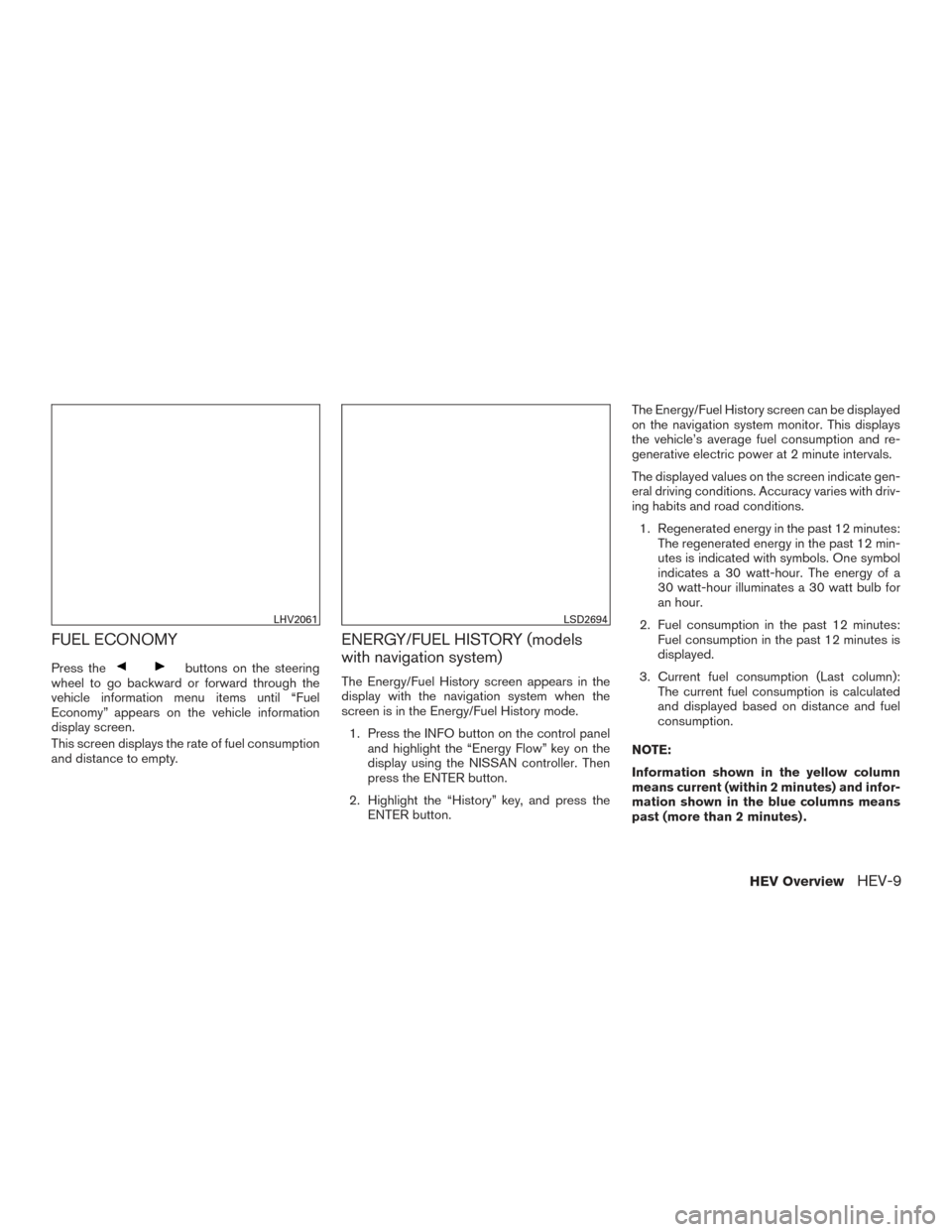
FUEL ECONOMY
Press thebuttons on the steering
wheel to go backward or forward through the
vehicle information menu items until “Fuel
Economy” appears on the vehicle information
display screen.
This screen displays the rate of fuel consumption
and distance to empty.
ENERGY/FUEL HISTORY (models
with navigation system)
The Energy/Fuel History screen appears in the
display with the navigation system when the
screen is in the Energy/Fuel History mode.
1. Press the INFO button on the control panel and highlight the “Energy Flow” key on the
display using the NISSAN controller. Then
press the ENTER button.
2. Highlight the “History” key, and press the ENTER button. The Energy/Fuel History screen can be displayed
on the navigation system monitor. This displays
the vehicle’s average fuel consumption and re-
generative electric power at 2 minute intervals.
The displayed values on the screen indicate gen-
eral driving conditions. Accuracy varies with driv-
ing habits and road conditions.
1. Regenerated energy in the past 12 minutes: The regenerated energy in the past 12 min-
utes is indicated with symbols. One symbol
indicates a 30 watt-hour. The energy of a
30 watt-hour illuminates a 30 watt bulb for
an hour.
2. Fuel consumption in the past 12 minutes: Fuel consumption in the past 12 minutes is
displayed.
3. Current fuel consumption (Last column): The current fuel consumption is calculated
and displayed based on distance and fuel
consumption.
NOTE:
Information shown in the yellow column
means current (within 2 minutes) and infor-
mation shown in the blue columns means
past (more than 2 minutes) .
LHV2061LSD2694
HEV OverviewHEV-9
Page 31 of 520
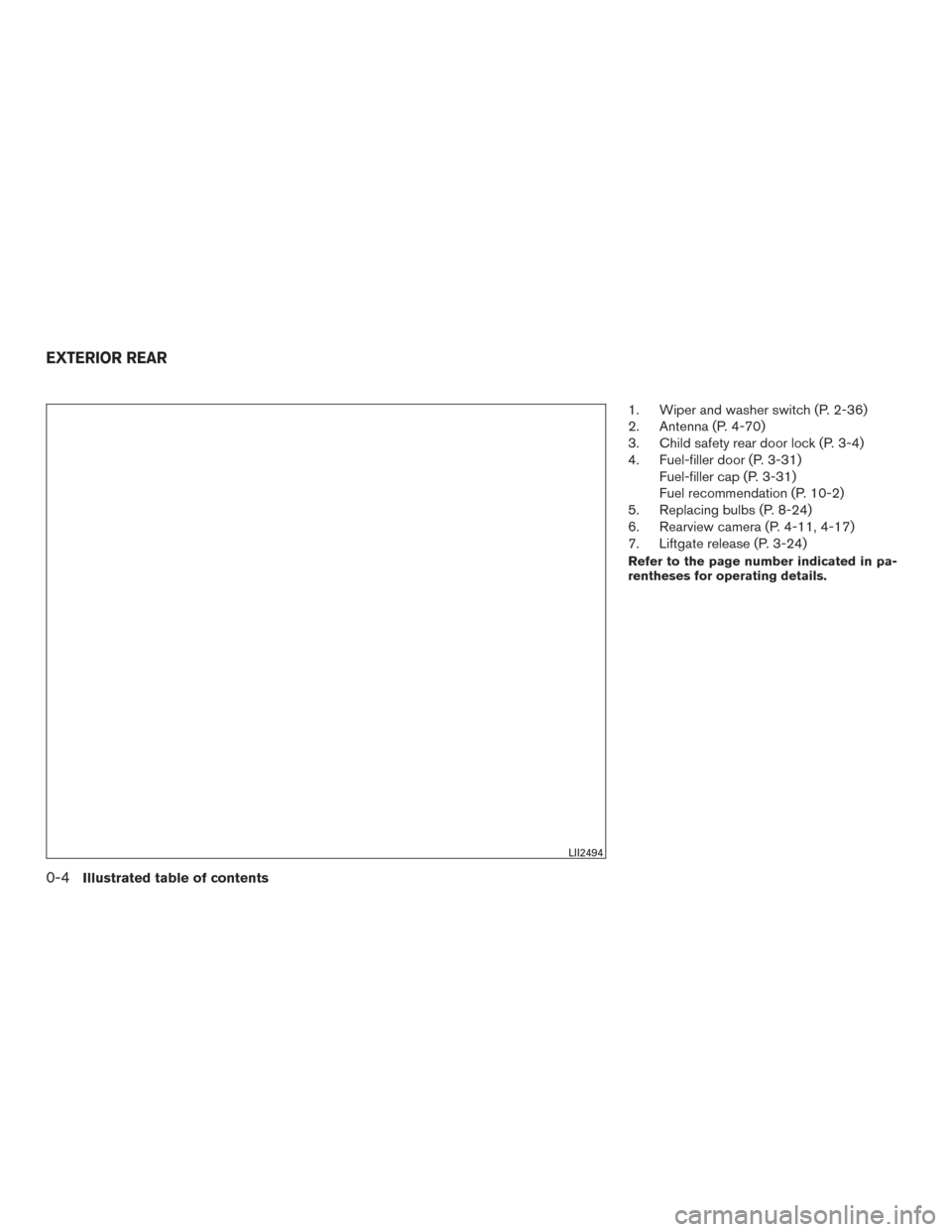
1. Wiper and washer switch (P. 2-36)
2. Antenna (P. 4-70)
3. Child safety rear door lock (P. 3-4)
4. Fuel-filler door (P. 3-31)Fuel-filler cap (P. 3-31)
Fuel recommendation (P. 10-2)
5. Replacing bulbs (P. 8-24)
6. Rearview camera (P. 4-11, 4-17)
7. Liftgate release (P. 3-24)
Refer to the page number indicated in pa-
rentheses for operating details.
LII2494
EXTERIOR REAR
0-4Illustrated table of contents
Page 34 of 520
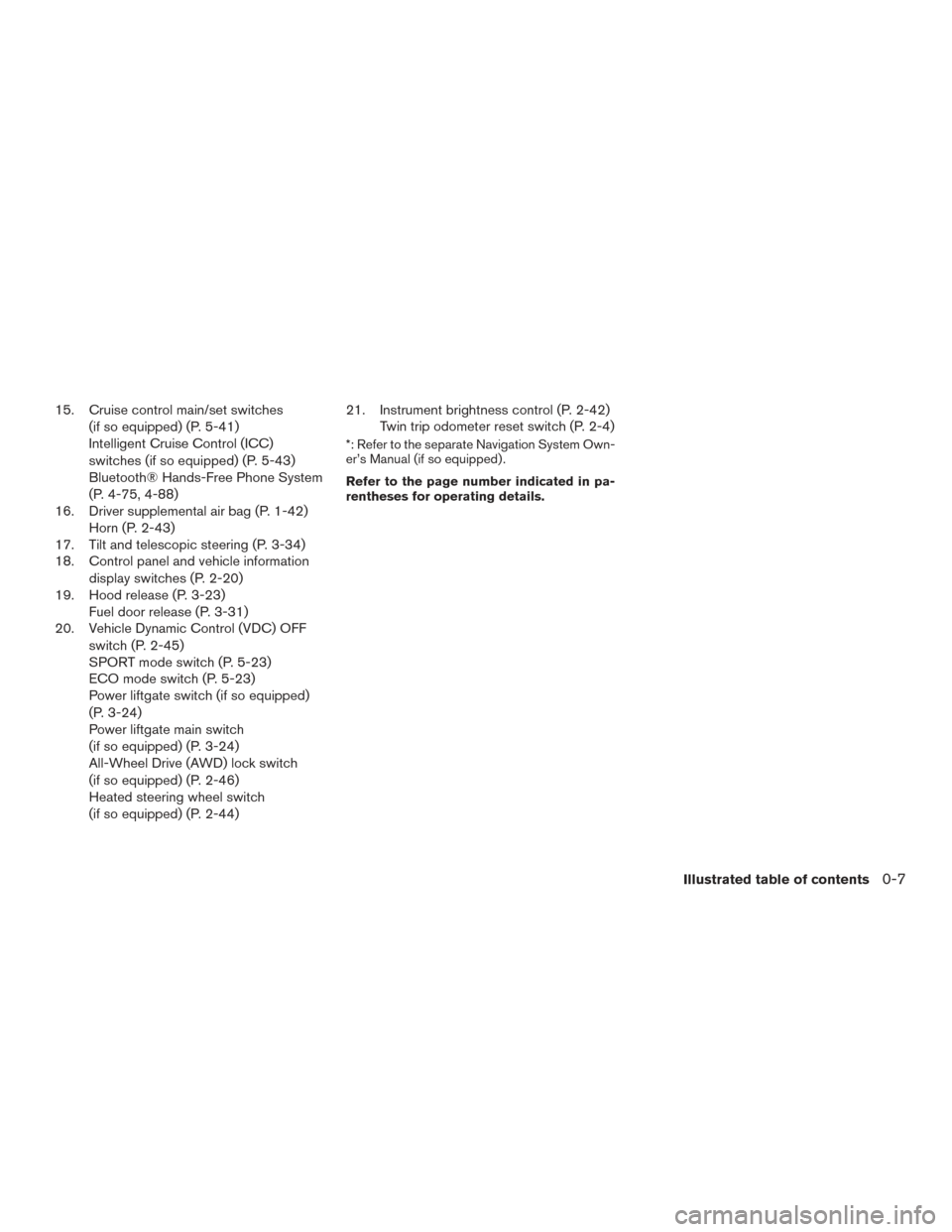
15. Cruise control main/set switches(if so equipped) (P. 5-41)
Intelligent Cruise Control (ICC)
switches (if so equipped) (P. 5-43)
Bluetooth® Hands-Free Phone System
(P. 4-75, 4-88)
16. Driver supplemental air bag (P. 1-42) Horn (P. 2-43)
17. Tilt and telescopic steering (P. 3-34)
18. Control panel and vehicle information
display switches (P. 2-20)
19. Hood release (P. 3-23) Fuel door release (P. 3-31)
20. Vehicle Dynamic Control (VDC) OFF
switch (P. 2-45)
SPORT mode switch (P. 5-23)
ECO mode switch (P. 5-23)
Power liftgate switch (if so equipped)
(P. 3-24)
Power liftgate main switch
(if so equipped) (P. 3-24)
All-Wheel Drive (AWD) lock switch
(if so equipped) (P. 2-46)
Heated steering wheel switch
(if so equipped) (P. 2-44) 21. Instrument brightness control (P. 2-42)
Twin trip odometer reset switch (P. 2-4)
*: Refer to the separate Navigation System Own-
er’s Manual (if so equipped) .
Refer to the page number indicated in pa-
rentheses for operating details.
Illustrated table of contents0-7